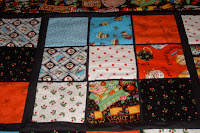The first time I saw a reference to a "Sudoku" quilt, I couldn't imagine what that would be! However, this summer I saw a kit in a quilt shop, and I looked at it briefly. Suffice it to say, I saw quickly that a kit was an unnecessary expense!
I have been collecting Mary Engelbreit pieces over the past several months, with no idea how I would use them, but wanting to make some type of quilt that would showcase this artist that I have admired for several years! As I thought about a sudoku quilt, I realized that I had almost enough ME pieces to do this type of quilt: 9 different ones. SO when I returned from my reunion/sister quilting trip, I got out my ME fabrics and began to plot/plan!
I had 7 ME fabrics, and I needed 9 for the sudoku, so I added a mottled red piece and a red polka-dot on white that I already had. I figured out the cuts I would need to make (9 squares 5.5 inches of each fabric), and then I planned and figured out how many 1-inch strips (flange) and 1.5-inch strips (sashing) I would need. My plan is to separate each square of fabric from the others with the flange, and to separate each 9-block grid with sashing. To make the sudoku even more interesting, I found some old "Extreme Sudokus," which means that each of the nine numbers is present in the left-to-right diagonal and in the right-to-left diagonal.
Finally, I assigned a number (1 to 9) to each fabric and separated the squares into 9 piles of the separate squares. Sewing the blocks together was just fun -- moving from square to square, adding the flange into each seam. In just a short time, I had completed one grid, and by the time I went to bed that night, I had the top row of three grids completed!
I won't bore you with pictures of all 9 grids, but if you want, I'll let you check my work when it is quilted, to be sure I haven't repeated a fabric in a row, column, grid, or diagonal!
As you can see, each fabric is set off within the grid with a narrow flange of black fabric, and each grid is separated with a one-inch sashing of black. After enclosing the entire sudoku with black sashing, I added a border of the print fabric on black that has the most representative images from ME art. The binding will be the cherries on black fabric.
While working on the quilt top, I decided to make use of left-over pieces of the fabrics to make a pieced backing -- something I've not done before. The pictures that follow show the result of that "design decision," and I'm pretty pleased with it!
As you can see, I have a strip of each of my nine fabrics, again separated by black sashing. They are presented in the order I used them in the sudoku, so the back will act as a sort of "key" to the puzzle! Then I added a wide border of the same fabric I used to border the quilt top.
(I tried to rotate this picture, with no success, so just tip your head to the side!) I'm very excited to get this quilted, but will restrain myself -- I'll wait until the robot quilt is done before I take this one to Cathy!
One thing I'm quite proud of is the success with which I used math to plan my quilt! I figured out how many 1-inch strips I needed for the flange, and I had exactly the number I needed, with small pieces left over. I also figured out how many 1.5-inch strips I needed for the sashing, and again was right on the mark. I will figure out how many strips I need for binding, and I will have that ready before the quilt is ready to be bound. Who says you don't need math in real life?!
If you decide to do a Sudoku quilt, I'll be glad to assist! This was really fun to do -- almost as much fun as solving a Sudoku!










Math is not my forte, but I do have to admit the Sudoku pattern is intriguing. I love the polychromatic colors as the Sudoku pattern brings order to the chaos. I love the creative use of the math blocks and how it ends up being a beautiful large quilt. I have not tried large blocks, except for my four-patch quilt, but this has inspired me.
ReplyDelete